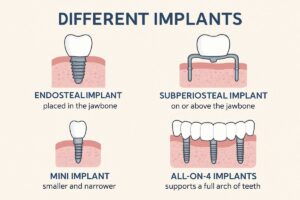Dental implants are a long-term way to replace missing teeth. People choose implants because they look natural, restore chewing, and help keep the jawbone healthy. This article explains how dental implants work, who should consider them, and practical steps to get started. You’ll also read about basic dent/i concepts used in modern implant care and what to expect from Flathead Dental Implant Arts.
How Dental Implants Work
Dental implants are small titanium posts placed into the jaw to act as artificial tooth roots. An implant has three main parts: the implant (the post in bone), the abutment (connects the post to the tooth), and the crown (the visible tooth). Over several months the bone grows around the implant — this is called osseointegration — and gives a stable, natural feel. Because the implant fuses with bone, implants let you chew and speak like you would with real teeth.
Basic dent/i Concepts Every Patient Should Know
The term dent/i here refers to the digital and implant workflow used in modern dentistry. In plain language, dent/i covers digital scans, 3D imaging, virtual planning, and computer-aided manufacturing that help plan and place implants more accurately. These tools let the team map your jaw, choose the best implant size and angle, and design crowns with a precise fit. That digital bridge from planning to surgery reduces surprises and improves results.
Who Is A Good Candidate For Implants?
Good candidates are generally healthy adults with one or more missing teeth and stable gums. Key factors doctors check:
- Overall health — uncontrolled diabetes or certain conditions may need management first.
- Jaw bone volume — enough bone is needed to hold the implant securely.
- Gum health — untreated gum disease must be controlled before implants.
- Smoking — smokers face higher risks of implant failure and slower healing.
If bone is thin, bone grafting or ridge augmentation can often provide enough support. Your dentist will evaluate and recommend the right prep if needed.
The Implant Process: Step-by-Step
Digital Planning & Imaging
CBCT (3D cone beam) scans show bone shape and nearby nerves. Digital planning software lets the team place implants virtually, check angles, and decide final crown positions. This planning reduces surprises during surgery and improves outcomes.
Guided Surgery & 3D Printed Guides
Surgical guides are printed from the digital plan. They fit over your teeth or gums and guide the drill to the exact position and angle. Guided surgery shortens surgery time, increases precision, and lowers the chance of complications.
Implant Placement, Sedation & Recovery
Sedation options range from local anesthesia to oral or IV sedation for comfort. On surgery day you can expect some swelling and mild discomfort for a few days. Most people return to normal activities within a week. Follow-up checks ensure healing and monitor osseointegration. Good oral hygiene and following aftercare instructions speed recovery.
Restoration: Crowns, Bridges, and CAD‑CAM Prosthetics
Once implants integrate, the restorative phase begins. Digital impressions and CAD‑CAM technology let labs or in-house mills create crowns, bridges, and full-arch prosthetics that match your bite and appearance precisely. This digital workflow often shortens lab time and gives a better fit.
Benefits, Risks, And Longevity
Major benefits:
- Improved function — eat and speak more easily.
- Aesthetics — natural-looking teeth that boost confidence.
- Bone preservation — implants stimulate bone and slow bone loss.
Possible risks and complications include infection, nerve irritation, sinus issues for upper implants, or implant failure if healing is poor. With good care, many implants last 15–25 years or longer. Regular dental visits, proper brushing and flossing, and quitting smoking increase lifespan.
Cost, Insurance, And Financing Options
Costs vary by how many implants, need for bone grafts, and the type of final prosthetic. Insurance sometimes covers part of the procedure, but often not the full cost. Many practices offer financing, payment plans, or third-party medical loans to make treatment manageable. Ask for an itemized estimate and options during your consult.
Why Choose Flathead Dental Implant Arts For Digital Implant Care
Flathead Dental Implant Arts in Kalispell blends modern digital workflows with patient-centered care. Dr. David Dodrill graduated cum laude with a DDS, completed advanced training, and focuses on ethical, compassionate treatment. He is active in the Flathead Valley through volunteer outreach and community projects that expand access to dental care.
Key Technologies Used
- Digital implant planning software for precise mapping
- CBCT imaging to view bone anatomy and critical structures
- In-house 3D printing for surgical guides and models
- Guided-surgery workflows to translate plans to the clinic
- Digital impressions and CAD‑CAM prosthetics for precise crowns
- Sedation technology to keep patients comfortable during procedures
What Patients Can Expect From The Experience
Patients report a gentle, family-like environment and streamlined care. The team focuses on clear communication, comfort measures during treatment, and predictable, efficient workflows so you get reliable results with less stress.
How To Get Started
To begin, bring any current dental X-rays, a list of medications, and notes about your health. Good questions to ask: Am I a candidate? What digital tests will you use? What are estimated costs and timelines? Call Flathead Dental Implant Arts in Kalispell to schedule an evaluation. The team will review your scans, explain options, and outline a clear plan for care.




